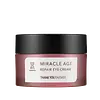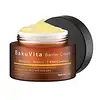What's inside
What's inside
 Key Ingredients
Key Ingredients

 Benefits
Benefits

 Concerns
Concerns

 Ingredients Side-by-side
Ingredients Side-by-side

Water
Skin ConditioningGlycerin
HumectantHydrogenated Poly(C6-14 Olefin)
EmollientDipentaerythrityl Hexa C5-9 Acid Esters
Skin ConditioningParaffinum Liquidum
EmollientCetearyl Alcohol
EmollientPolyglyceryl-3 Methylglucose Distearate
EmulsifyingButylene Glycol
HumectantBetaine
HumectantCyclopentasiloxane
EmollientCaprylic/Capric Triglyceride
MaskingNiacinamide
SmoothingHydrogenated Polyisobutene
EmollientButyrospermum Parkii Butter
Skin ConditioningDioscorea Japonica Root Extract
Skin ConditioningArctium Lappa Root Extract
Skin ConditioningPhellinus Linteus Extract
Skin ConditioningPiper Methysticum Leaf/Root/Stem Extract
Skin ConditioningPortulaca Oleracea Extract
Skin ConditioningPueraria Thunbergiana Root Extract
Skin ConditioningGlycyrrhiza Glabra Root Extract
BleachingPaeonia Lactiflora Root Extract
Skin ConditioningCnidium Officinale Root Extract
Skin ConditioningSoluble Collagen
HumectantAloe Barbadensis Leaf Juice
Skin ConditioningSodium Hyaluronate
HumectantHydrogenated Lecithin
EmulsifyingArgania Spinosa Kernel Oil
EmollientGlyceryl Stearate
EmollientBeeswax
Emulsion StabilisingPolyacrylate-13
Polyisobutene
Cetyl Alcohol
EmollientButylene/Ethylene/Styrene Copolymer
Ethylene/Propylene/Styrene Copolymer
Tocopheryl Acetate
AntioxidantSodium Stearoyl Glutamate
CleansingAllantoin
Skin ConditioningPolyquaternium-51
Skin ConditioningGlycosyl Trehalose
Emulsion StabilisingAdenosine
Skin ConditioningDisodium EDTA
Hydrogenated Starch Hydrolysate
HumectantRaffinose
Skin ConditioningCeteth-20
CleansingSteareth-20
CleansingBiosaccharide Gum-1
HumectantBisabolol
MaskingSodium Polyacrylate
AbsorbentPanthenol
Skin ConditioningLecithin
EmollientXanthan Gum
EmulsifyingFolic Acid
Skin ConditioningCeramide NP
Skin ConditioningDicaprylyl Carbonate
EmollientCholesterol
EmollientSucrose Distearate
EmollientTromethamine
BufferingPalmitoyl Pentapeptide-4
Skin ConditioningPolysorbate 20
EmulsifyingPEG-100 Stearate
PEG-75 Stearate
Parfum
Masking1,2-Hexanediol
Skin ConditioningPhenoxyethanol
PreservativeEthylhexylglycerin
Skin ConditioningCI 19140
Cosmetic ColorantCI 15985
Cosmetic ColorantWater, Glycerin, Hydrogenated Poly(C6-14 Olefin), Dipentaerythrityl Hexa C5-9 Acid Esters, Paraffinum Liquidum, Cetearyl Alcohol, Polyglyceryl-3 Methylglucose Distearate, Butylene Glycol, Betaine, Cyclopentasiloxane, Caprylic/Capric Triglyceride, Niacinamide, Hydrogenated Polyisobutene, Butyrospermum Parkii Butter, Dioscorea Japonica Root Extract, Arctium Lappa Root Extract, Phellinus Linteus Extract, Piper Methysticum Leaf/Root/Stem Extract, Portulaca Oleracea Extract, Pueraria Thunbergiana Root Extract, Glycyrrhiza Glabra Root Extract, Paeonia Lactiflora Root Extract, Cnidium Officinale Root Extract, Soluble Collagen, Aloe Barbadensis Leaf Juice, Sodium Hyaluronate, Hydrogenated Lecithin, Argania Spinosa Kernel Oil, Glyceryl Stearate, Beeswax, Polyacrylate-13, Polyisobutene, Cetyl Alcohol, Butylene/Ethylene/Styrene Copolymer, Ethylene/Propylene/Styrene Copolymer, Tocopheryl Acetate, Sodium Stearoyl Glutamate, Allantoin, Polyquaternium-51, Glycosyl Trehalose, Adenosine, Disodium EDTA, Hydrogenated Starch Hydrolysate, Raffinose, Ceteth-20, Steareth-20, Biosaccharide Gum-1, Bisabolol, Sodium Polyacrylate, Panthenol, Lecithin, Xanthan Gum, Folic Acid, Ceramide NP, Dicaprylyl Carbonate, Cholesterol, Sucrose Distearate, Tromethamine, Palmitoyl Pentapeptide-4, Polysorbate 20, PEG-100 Stearate, PEG-75 Stearate, Parfum, 1,2-Hexanediol, Phenoxyethanol, Ethylhexylglycerin, CI 19140, CI 15985
Water
Skin ConditioningGlycerin
Humectant1,2-Hexanediol
Skin ConditioningNiacinamide
SmoothingDicaprylyl Carbonate
EmollientCetearyl Alcohol
EmollientCetyl Ethylhexanoate
EmollientPropanediol
SolventMethyl Trimethicone
Skin ConditioningPanthenol
Skin ConditioningLaminaria Japonica Extract
Skin ProtectingEclipta Prostrata Leaf Extract
Skin ConditioningAstragalus Membranaceus Root Extract
EmollientPoria Cocos Extract
Skin ConditioningMagnolia Sieboldii Extract
Skin ConditioningMagnolia Liliflora Flower Extract
Skin ConditioningCnidium Officinale Root Extract
Skin ConditioningBenincasa Cerifera Seed Extract
Skin ConditioningPrunus Persica Kernel Extract
MoisturisingMalt Extract
Skin ProtectingElaeis Guineensis Oil
EmollientHydrogenated Lecithin
EmulsifyingBakuchiol
AntimicrobialPotassium Cetyl Phosphate
EmulsifyingAmmonium Polyacryloyldimethyl Taurate
Emulsion StabilisingHydroxyethyl Acrylate/Sodium Acryloyldimethyl Taurate Copolymer
Emulsion StabilisingCetearyl Olivate
Sorbitan Olivate
Emulsifying3-O-Ethyl Ascorbic Acid
Skin ConditioningXanthan Gum
EmulsifyingTocopherol
AntioxidantButylene Glycol
HumectantAdenosine
Skin ConditioningDisodium EDTA
Sorbitan Isostearate
EmulsifyingT-Butyl Alcohol
PerfumingFructooligosaccharides
HumectantBeta-Glucan
Skin ConditioningHydrolyzed Hyaluronic Acid
HumectantAscorbic Acid Polypeptide
AntioxidantEthylhexylglycerin
Skin ConditioningWater, Glycerin, 1,2-Hexanediol, Niacinamide, Dicaprylyl Carbonate, Cetearyl Alcohol, Cetyl Ethylhexanoate, Propanediol, Methyl Trimethicone, Panthenol, Laminaria Japonica Extract, Eclipta Prostrata Leaf Extract, Astragalus Membranaceus Root Extract, Poria Cocos Extract, Magnolia Sieboldii Extract, Magnolia Liliflora Flower Extract, Cnidium Officinale Root Extract, Benincasa Cerifera Seed Extract, Prunus Persica Kernel Extract, Malt Extract, Elaeis Guineensis Oil, Hydrogenated Lecithin, Bakuchiol, Potassium Cetyl Phosphate, Ammonium Polyacryloyldimethyl Taurate, Hydroxyethyl Acrylate/Sodium Acryloyldimethyl Taurate Copolymer, Cetearyl Olivate, Sorbitan Olivate, 3-O-Ethyl Ascorbic Acid, Xanthan Gum, Tocopherol, Butylene Glycol, Adenosine, Disodium EDTA, Sorbitan Isostearate, T-Butyl Alcohol, Fructooligosaccharides, Beta-Glucan, Hydrolyzed Hyaluronic Acid, Ascorbic Acid Polypeptide, Ethylhexylglycerin
Ingredients Explained
These ingredients are found in both products.
Ingredients higher up in an ingredient list are typically present in a larger amount.
1,2-Hexanediol is a synthetic liquid and another multi-functional powerhouse.
It is a:
- Humectant, drawing moisture into the skin
- Emollient, helping to soften skin
- Solvent, dispersing and stabilizing formulas
- Preservative booster, enhancing the antimicrobial activity of other preservatives
Adenosine is in every living organism. It is one of four components in nucleic acids that helps store our DNA.
Adenosine has many benefits when used. These benefits include hydrating the skin, smoothing skin, and reducing wrinkles. Once applied, adenosine increases collagen production. It also helps with improving firmness and tissue repair.
Studies have found adenosine may also help with wound healing.
In skincare products, Adenosine is usually derived from yeast.
Learn more about AdenosineButylene Glycol (or BG) is used within cosmetic products for a few different reasons:
Overall, Butylene Glycol is a safe and well-rounded ingredient that works well with other ingredients.
Though this ingredient works well with most skin types, some people with sensitive skin may experience a reaction such as allergic rashes, closed comedones, or itchiness.
Learn more about Butylene GlycolCetearyl alcohol is a mixture of two fatty alcohols: cetyl alcohol and stearyl alcohol. It is mainly used as an emulsifier. Emulsifiers help prevent the separation of oils and products. Due to its composition, it can also be used to thicken a product or help create foam.
Cetearyl alcohol is an emollient. Emollients help soothe and hydrate the skin by trapping moisture.
Studies show Cetearyl alcohol is non-toxic and non-irritating. The FDA allows products labeled "alcohol-free" to have fatty alcohols.
This ingredient is usually derived from plant oils such as palm, vegetable, or coconut oils. There is debate on whether this ingredient will cause acne.
Due to the fatty acid base, this ingredient may not be Malassezia folliculitis safe.
Learn more about Cetearyl AlcoholWe don't have a description for Cnidium Officinale Root Extract yet.
Dicaprylyl Carbonate comes from carbonic acid and caprylyl alcohol, a fatty alcohol. It is an emollient and gives skin a velvet feel. The sources of Dicaprylyl Carbonate may be synthetic or from animals.
As an emollient, Dicaprylyl Carbonate creates a film on the skin. This film traps moisture in, keeping your skin soft and hydrated.
Disodium EDTA plays a role in making products more stable by aiding other preservatives.
It is a chelating agent, meaning it neutralizes metal ions that may be found in a product.
Disodium EDTA is a salt of edetic acid and is found to be safe in cosmetic ingredients.
Learn more about Disodium EDTAEthylhexylglycerin (we can't pronounce this either) is commonly used as a preservative and skin softener. It is derived from glyceryl.
You might see Ethylhexylglycerin often paired with other preservatives such as phenoxyethanol. Ethylhexylglycerin has been found to increase the effectiveness of these other preservatives.
Glycerin is already naturally found in your skin. It helps moisturize and protect your skin.
A study from 2016 found glycerin to be more effective as a humectant than AHAs and hyaluronic acid.
As a humectant, it helps the skin stay hydrated by pulling moisture to your skin. The low molecular weight of glycerin allows it to pull moisture into the deeper layers of your skin.
Hydrated skin improves your skin barrier; Your skin barrier helps protect against irritants and bacteria.
Glycerin has also been found to have antimicrobial and antiviral properties. Due to these properties, glycerin is often used in wound and burn treatments.
In cosmetics, glycerin is usually derived from plants such as soybean or palm. However, it can also be sourced from animals, such as tallow or animal fat.
This ingredient is organic, colorless, odorless, and non-toxic.
Glycerin is the name for this ingredient in American English. British English uses Glycerol/Glycerine.
Learn more about GlycerinHydrogenated Lecithin is created from the hydrogenation of lecithin (a group of phospholipids). Hydrogenation is a chemical reaction between hydrogen and another element.
This ingredient is an emollient and emulsifier. As an emollient, it helps soften skin by trapping moisture within. As an emulsifier, it prevents oil and water ingredients from separating.
Niacinamide is a multitasking form of vitamin B3 that strengthens the skin barrier, reduces pores and dark spots, regulates oil, and improves signs of aging.
And the best part? It's gentle and well-tolerated by most skin types, including sensitive and reactive skin.
You might have heard of "niacin flush", or the reddening of skin that causes itchiness. Niacinamide has not been found to cause this.
In very rare cases, some individuals may not be able to tolerate niacinamide at all or experience an allergic reaction to it.
If you are experiencing flaking, irritation, and dryness with this ingredient, be sure to double check all your products as this ingredient can be found in all categories of skincare.
When incorporating niacinamide into your routine, look out for concentration amounts. Typically, 5% niacinamide provides benefits such as fading dark spots. However, if you have sensitive skin, it is better to begin with a smaller concentration.
When you apply niacinamide to your skin, your body converts it into nicotinamide adenine dinucleotide (NAD). NAD is an essential coenzyme that is already found in your cells as "fuel" and powers countless biological processes.
In your skin, NAD helps repair cell damage, produce new healthy cells, support collagen production, strengthen the skin barrier, and fight environmental stressors (like UV and pollution).
Our natural NAD levels start to decline with age, leading to slower skin repair, visible aging, and a weaker skin barrier. By providing your skin niacinamide, you're recharging your skin's NAD levels. This leads to stronger, healthier, and younger looking skin.
Another name for vitamin B3 is nicotinamide. This vitamin is water-soluble and our bodies don't store it. We obtain Vitamin B3 from either food or skincare. Meat, fish, wheat, yeast, and leafy greens contain vitamin B3.
The type of niacinamide used in skincare is synthetically created.
Learn more about NiacinamidePanthenol is a common ingredient that helps hydrate and soothe the skin. It is found naturally in our skin and hair.
There are two forms of panthenol: D and L.
D-panthenol is also known as dexpanthenol. Most cosmetics use dexpanthenol or a mixture of D and L-panthenol.
Panthenol is famous due to its ability to go deeper into the skin's layers. Using this ingredient has numerous pros (and no cons):
Like hyaluronic acid, panthenol is a humectant. Humectants are able to bind and hold large amounts of water to keep skin hydrated.
This ingredient works well for wound healing. It works by increasing tissue in the wound and helps close open wounds.
Once oxidized, panthenol converts to pantothenic acid. Panthothenic acid is found in all living cells.
This ingredient is also referred to as pro-vitamin B5.
Learn more about PanthenolWater. It's the most common cosmetic ingredient of all. You'll usually see it at the top of ingredient lists, meaning that it makes up the largest part of the product.
So why is it so popular? Water most often acts as a solvent - this means that it helps dissolve other ingredients into the formulation.
You'll also recognize water as that liquid we all need to stay alive. If you see this, drink a glass of water. Stay hydrated!
Learn more about WaterXanthan gum is used as a stabilizer and thickener within cosmetic products. It helps give products a sticky, thick feeling - preventing them from being too runny.
On the technical side of things, xanthan gum is a polysaccharide - a combination consisting of multiple sugar molecules bonded together.
Xanthan gum is a pretty common and great ingredient. It is a natural, non-toxic, non-irritating ingredient that is also commonly used in food products.
Learn more about Xanthan Gum